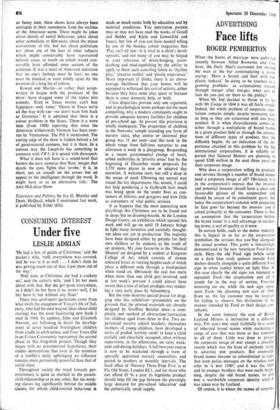Face lifts
ADVERTISING ROGER PEMBERTON
When the banns of marriage were published recently between Allied Breweries and Uni-
lever, the Daily Mail's cartoonist Jon showed the man at the bar contemplating a poster saying: 'Have a Scotch and Surf with free plastic tankard.' In doing so he touched on a growing problem : as corporations expand through merger after merger, what sort of face do you put on them to the public?
When Mr Ind decided to throw in his lot with Mr Coope in 1844 it was all fairly simple. Indeed, the whole problem of corporate repu- tations remains simple, despite increasing size, so long as they are concerned with one basic
product. It is when diversification comes in,
either through a multiplicity of brand names in a given product field or through the annexa- tions of different types of product, that the
difficulty begins. As an indication of the im- portance attached to this problem by the big international corporations, it is reliably re- ported that General Motors are planning to spend $200 million in the next three years on their corporate image.
Why does a corporation selling its products and services through a number of brand names need a corporate image at all? Obviously it is in the corporation's interest that the investor and potential investor should have a clear and
favourable picture of the corporation and should be aware of its constituent parts; but today the corporation's concern with projecting its face goes far beyond the investor and is aimed primarily at the consumer. There is thus an assumption that the 'corporation behind the brand name' is a real advantage in market- ing terms, a seal of quality as it were.
In certain fields, such as the motor industry, this is logical in so far as the corporation symbolises the services that yoebuy alongside the actual product. This point is interestingly demonstrated in the new American Ford house style. Here. the old Ford sign (white script
on a dark blue oval) appears outside Ford dealers directly alongside a quite different Ford
sign in white capital letters on light blue. In
this case clearly the old signs are intended to represent Ford—the corporation and all it
stands for in the way of service, Five-star
motoring etc etc, while the new sign repre- sents Ford—the gleaming new cars of 1968.
Even so, the lay customer may be forgiven for failing to observe this distinction in the manner intended by Ford or their design con- sultants.
In the same industry the case of British Leyland Motors is instructive in a different way. For years BMC stuck faithfully to a series of inherited brand names while marketing a range of cars that was more or less common to all of them. Little was done to project the corporate image of BMC except a dreadful rosette which was the bane of anybody trying to advertise BMC products. But eventually brand names became so subordinated to types that even police messages on the wireless now refer to 'a BMC 1100'; and it was the Ma and its younger brothers that were really begin- ning, despite the old brand names, to give BMC a worthwhile corporate identity when it was taken over by Leyland.
Of course, it is where the names of corpora- tion and brand coincide that the corporation is most concerned about its image. The big oil companies, retailing more or less identical products at more or less identical prices, and with very little competitive advantage to offer in the way of extra service at the point of sale, are especially concerned with their cor- porate reputations. Some years ago a leading oil company commissioned a worldwide atti- tude survey about itself which concluded that it was, in the eyes of the public, 'a cold, face- less monolith.' It is against this sort of background that the appearance of petrol stations has been so vastly improved in recent years, and so much petrol advertising seeks to
make the motorist feel warmly towards the cor- poration that keeps him on the road.
Paradoxically, the marketing-based mergers that affect the public most widely in an every- day sense, such as that proposed between Uni- lever and Allied Breweries, present the least problems of corporate identity vis-à-vis the consumer. Allied. for example, is finding new markets for its products and Unilever is finding new products for its markets (Jon. of course, is postulating the reverse proposition). There will be no gasps of dismay from the house- wife when she can buy (subject to the licensing laws) Long Life beer alongside her Lifebuoy soap.



































 Previous page
Previous page